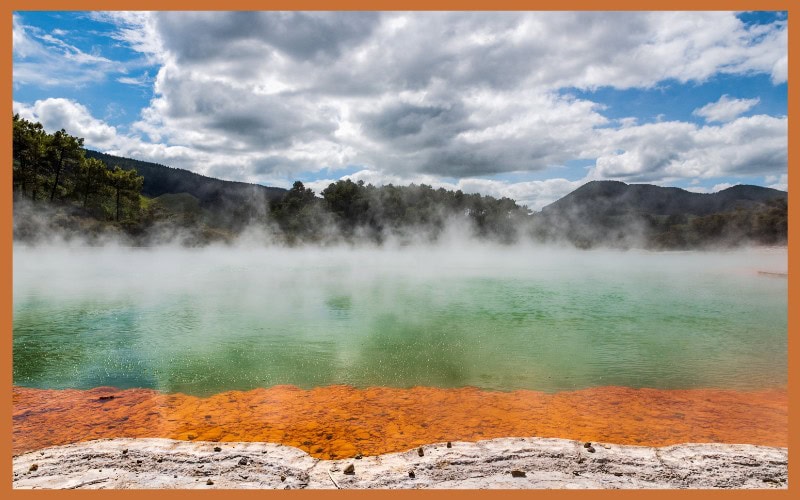What to See in New Zealand’s Steamy North Island
Artsy Traveler contains affiliate links for products and services I personally use and can happily recommend. As an Amazon Associate, I earn from qualifying purchases. Please read the Disclosure for more information. If you make a purchase through these links, at no additional cost to you, Artsy Traveler earns a small commission. Thank you!
No trip to New Zealand is complete without spending time in the simmering center of New Zealand’s North Island, where the ground steams, the lakes bubble, and the air smells faintly of sulfur and adventure.
Allow at least four days to explore the core of New Zealand’s steamy North Island: hike among volcanoes in Tongariro National Park and steep yourself (sometimes literally) in the geothermal wonders of Rotorua.
It’s New Zealand turned inside out — the raw earth on full display. In this post, I cover the highlights of the steamy North Island:
- Guided hike in Tongariro National Park
- Geothermal Sites in and around Rotorua
- Māori Evenings in Rotorua
Here’s a map of the places mentioned in this post:
From Wellington to Tangariro National Park
If you’ve taken the ferry from the South Island to the North Island, you’ll set off from Wellington (#1). It’s a leisurely four-hour drive north to Tongariro National Park, a distance of 336 kilometers.
Don’t Miss Bulls
The drive takes you through the lovely little town of Bulls (#2) where I suggest you stop for lunch and enjoy the plethora of bull puns.
Social-a-bull is the town hall, Relieve-a-bull is the town toilets, Read-a-bull is the town library, Delect-a-bull is the café where we eat lunch, and on it goes.
Love that Kiwi humor!
Tongariro National Park
Spend at least two nights and a full day (preferably two full days) in Tongariro National Park (#3), a spectacular area of New Zealand’s North Island. You won’t run out of hikes and drives to explore this incredibly scenic landscape.
I recommend you take a guided walking tour (or even attempt the nineteen kilometer Tongariro Crossing), check out jagged lava rock formations on Mount Ruapehu (#4) and best of all, take a scenic flight over Mount Ngauruhoe (#5), AKA Mount Doom.
Read on for details!
Staying in Tongariro National Park
Since the closure of the iconic Chateau Tongariro in 2023, accommodation options are somewhat limited in the park. Here are some suggestions:
- Skotel Alpine Resort (#6): Family friendly place close to the Tongariror National Park Whakapapa Visitor Centre
- Mountain Heights Lodge (#7): A motel near Tongariro National Park
- The Park Hotel Ruapehu (#8): Affordable accommodations in a stunning alpine setting in Tongariro National Park
Tongariro Crossing
The big attraction in Tongariro National Park is the Tongariro Crossing, one of New Zealand’s most popular tracks. It’s a nineteen kilometer one-way track that takes hikers up and over an alpine pass between Mount Ngauruhoe and Mount Tongariro.
While planning my trip to New Zealand, I seriously considered doing the crossing. My daughter (intrepid travel companion Julia) studied maps, while I worried about having the right boots and clothes.
The hike lasts for about eight hours. That’s a lot of walking!
Despite our misgivings, we decided to give it a go and booked to take a guided crossing with Adrift Tongariro Guiding.
Then, a few weeks before flying to New Zealand, we chickened out and decided to cancel the crossing and opt instead for the half-day hikes also offered by Adrift Tongariro Guiding. You can check availability of the tour with GetYourGuide:
Half Day Tongariro Hike with Adrift Tongariro Guiding
The tour is advertised as an alternative for people who have decided not to attempt the entire crossing or don’t have the time. The itinerary is vaguem, dependent on the will of the group on any particular day. Well, how hard can it be?
Here’s my experience completing the two hikes during the morning. Spoiler alert, I totally recommend it!
Hike 1 to Soda Springs
We are picked up at our hotel at 8:30 am by a young man in a white van and driven along with four people from Barcelona to the trail head for the Tongariro Crossing. We join the throngs for the first hour of the hike.
Note: If you decide to do the Tongariro Crossing, be warned that the trail can get very crowded. It didn’t look like a lot of fun to me, to be honest!
Just before the trail veers upwards to the Devil’s Staircase, we hang a left and scramble up to Soda Springs—a waterfall across the valley from Mount Ngauruhoe.
We are blessed with perfect conditions for the first hour of the hike. The sky is achingly blue and the perfect cone of Mount Ngauruhoe is postcard perfect.
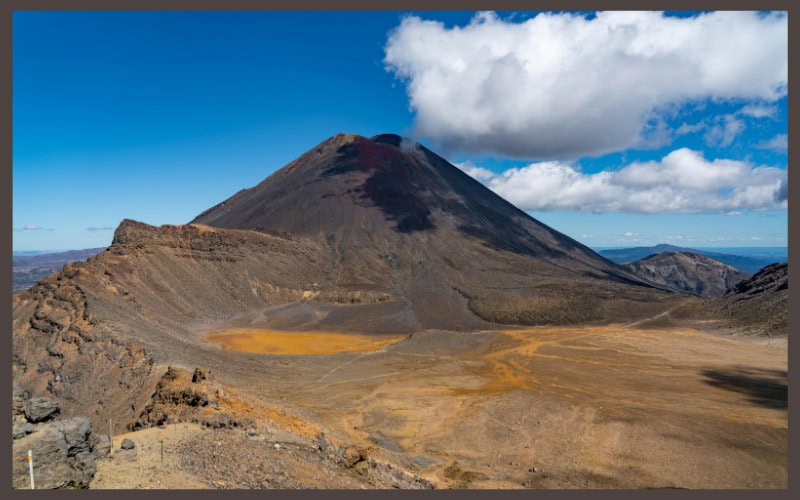
Hike 2: Hike up Mount Pukakaikiore
After we hike back to the car park, the guide drives about ten minutes for the start of our second hike. This one takes us up an extinct volcano and is considerably more challenging than the well-groomed track of the Tongariro Crossing.
We start off walking through waist-high bracken and heather along a very rough track full of holes waiting to swallow ankles. The guide presses cheerfully on and we follow, pushing aside branches, watching anxiously for holes. We emerge from the thick bushes that in most places obscures the track to find ourselves on the flank of a small, presumably extinct, volcano.
We are to climb to the top along a barely defined track.
The slope is very steep, and really too much for me, but the guide insists I can make it and so I start up. He suggests short steps and a steady pace. After about fifty meters, he asks if I’d like a pole. I grasp at it like a drowning woman.
It feels precarious and exposed on the steep slope, although compared to the giants surrounding us, the volcano we are on is pretty tame. E ven so, I don’t dare look down and I dread looking up to see how far there is to go.
The Spaniards pass me at a annoyingly speedy clip and I’m obliged to show my ego to the door. I’ll be glad if I can make it to the top without tumbling backwards. If it takes half the day, well, they can wait. Maybe they can have a siesta at the summit.
I plod slowly, painfully up, up, up, the slope rising steeply, the guide several paces above exhorts me forward with cheerful optimism. Julia stays at my side, willing me forward, assuring me that I’ll feel great when I make it to the top.
I count the steps one to ten, pause, breathe, count another ten steps, pause, breathe. I’m Edmund Hillary making the final ascent on Everest (he was a Kiwi after all).
Up ahead, the Spaniards and the guide are already at the top. The guide tells me the steepest part is over. Yeah, right. Ten more steps, pause, breathe, look. Indeed, the top is within reach.
I gather my resources (such a great phrase) and push my legs to the top, striding with some confidence and less pain now that I am sure of victory.
In comparison to the monster volcanoes spread out before me, little 500,000 year old Pukakaikiore looks like a forgotten pimple on the volcanic plain, but I feel like I’ve just summited Mount Doom.

For the rest of the afternoon following our descent, I gaze across the valley at it with great satisfaction. Dwarfed by Mt. Ngauruhoe’s tall and perfect cone—the star quarterback looming over the washed up old guy spitting memories in the corner—little Pukakaikiore remains my personal Everest.
Mt. Rupahoe – Lord of the Rings Location
After lunch and a bit of a rest from our morning hike, we set off to explore the ski area on Mt. Rupahoe, the third of the three large volcanoes populating the park.
Just above the ski area is, according to Julia’s handy Lord of the Rings Location Guidebook, the location where many of the scenes with Frodo and Sam climbing Mount Doom were filmed. The area is apparently rife with cool black rocks.
Well, indeed it is. The drive up to the ski area is as spectacular as so many of our drives in New Zealand.
We park and follow signs to the Mead Wall. A short hike brings us to a ridge strewn with rocks that look like they’ve been tossed by giants. Filming up here must have been a challenge!


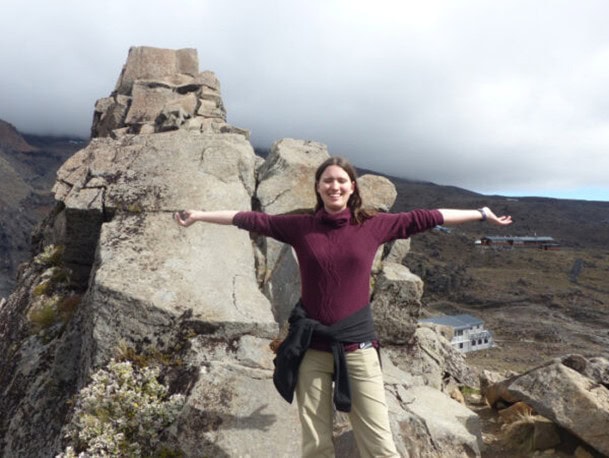
Tongariro Flightseeing Tour
We wake up to greet a perfect day. The volcanoes are 3-D cut-outs against the stark blue skies. We decide to cap our Tongariro visit with a flightseeing tour.
Julia calls promptly at 8 am when the Mountain Air company just down the road opens and books us for a 9:30 flight of 25 minutes that will take us over the Tongariro Crossing and around Mt. Ngauruhoe.
Just Julia and I board the four-seater plane along with Oliver, our pilot.
Julia rides shot gun at the front while I squeeze into the back seat. For the next 25 minutes, we are treated to close up views of the volcanoes and 360-degree views of the entire Tongariro National Park and beyond.
I snap picture after picture, pausing every so often to just watch awestruck at the landscape spiraling into eternity below me. We fly over and around Mt. Ngauruhoe and see clearly the lava flows from the various eruptions over the past decades.
People apparently climb the shifting scree slope, but I can’t find what route they could use. No climbers are on the mountain this early in the day. To me, the perfectly circular cone looks impossible to climb from every viewpoint.
After 25 minutes that feels like 5 minutes, we land on the grass field with barely a bump, happy and a bit sad to be back again on earth. We agree that the cost of the flight is worth every penny.
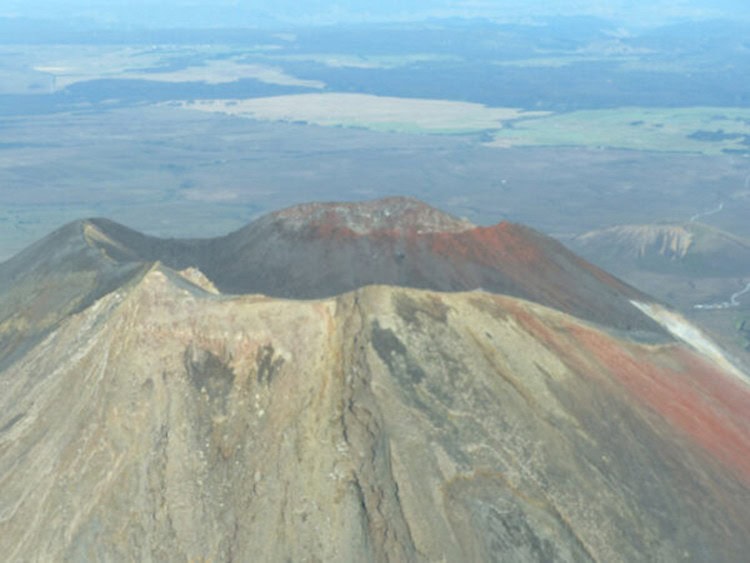
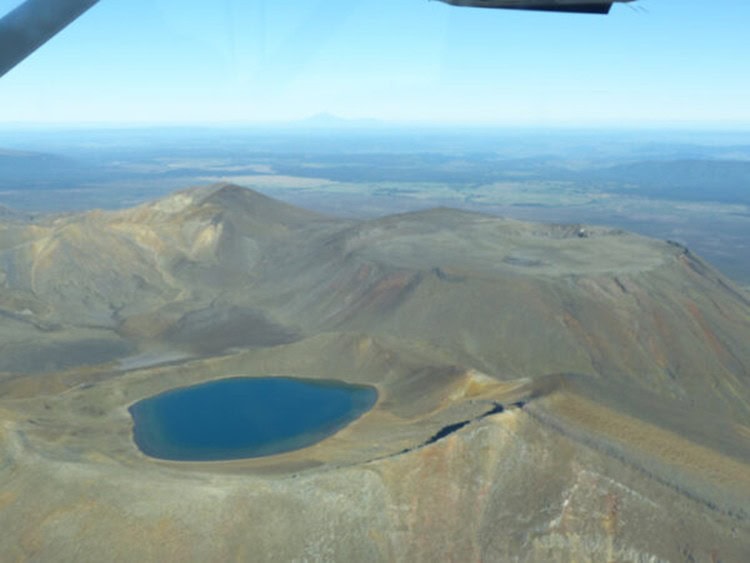
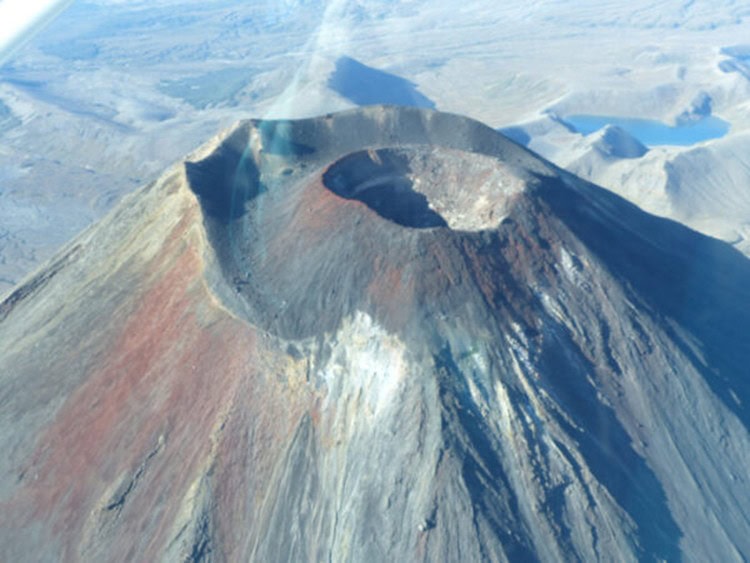
Back in the car, we head north for our next adventure—two nights in the middle of a giant caldera otherwise known as Rotorua.
Rotorua: North Island Must-See
It’s just a two hour drive to Rotorua. We made two stops: at Lake Taupo and at Wai-o-Tapu Thermal Wonderland.
Lake Taupo
Definitely include a pit stop at Lake Taupo (#9), the largest freshwater lake in New Zealand. A highlight is Huka Falls (#10) which we stop to admire. It’s a raging white water spectacle surging through the shallow gorge.
There is no charge to visit the falls or use the car park.
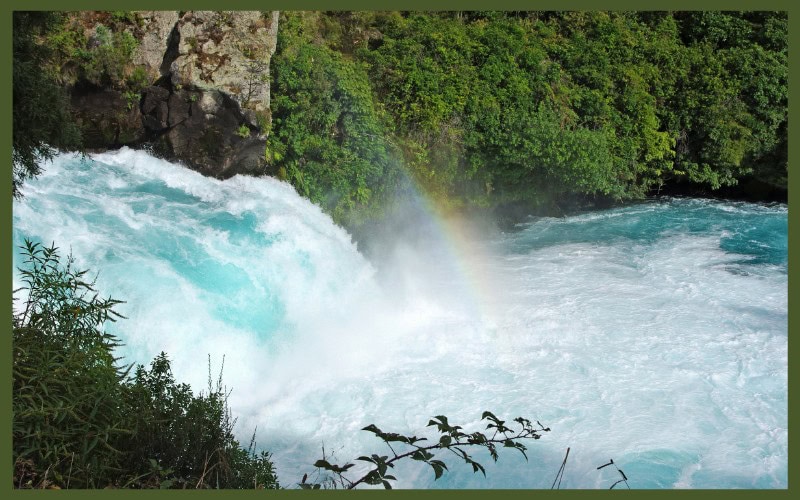
If you have time, linger awhile at Lake Taupo and take one of the many cruises to view Māori rock carvings. Here are some options with GetYourGuide:
Waiotapu Thermal Wonderland
About half an hour south of Rotorua, Waiotapu Thermal Wonderland (#11) is a must-see. Set aside several hours to enjoy what has to be one of the coolest (well, hottest) geothermal areas I’ve ever seen—and I’ve been to Yellowstone.
Bubbling mud, hissing fissures, boiling lakes with day-glo colored edges, a pool the color of toxic waste are all spread across an area laced by walkways. Signs everywhere exhort visitors to keep to the path, the implication being that one false step leads to death.
At the Champagne Pool, I ask the ranger guy if anyone has ever been injured at the site. He tells me that back in the 1960’s a local teacher visited the site with his dog. In those days, a fence did not separate the walkway from the Champagne Pool. The man’s dog ran into the pool and the man ran after the dog to save it.
Both died—quickly. On that sobering note, we keep snapping pictures, awed by the display of nature’s true colors.
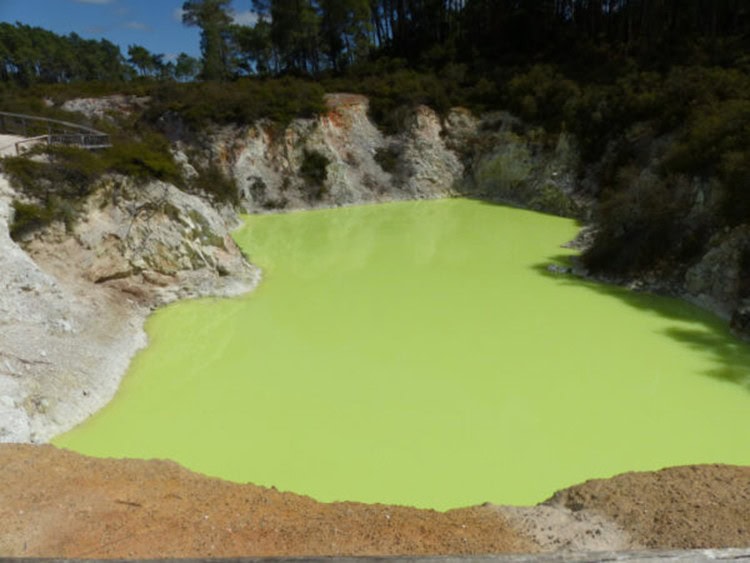
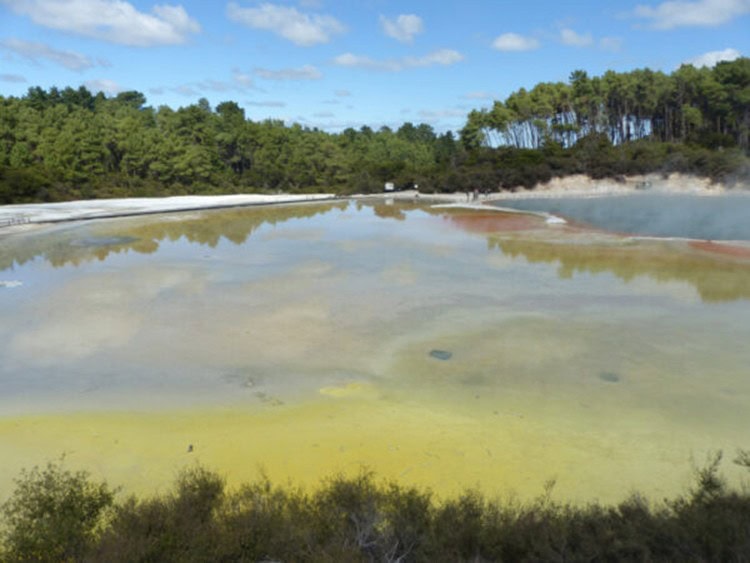
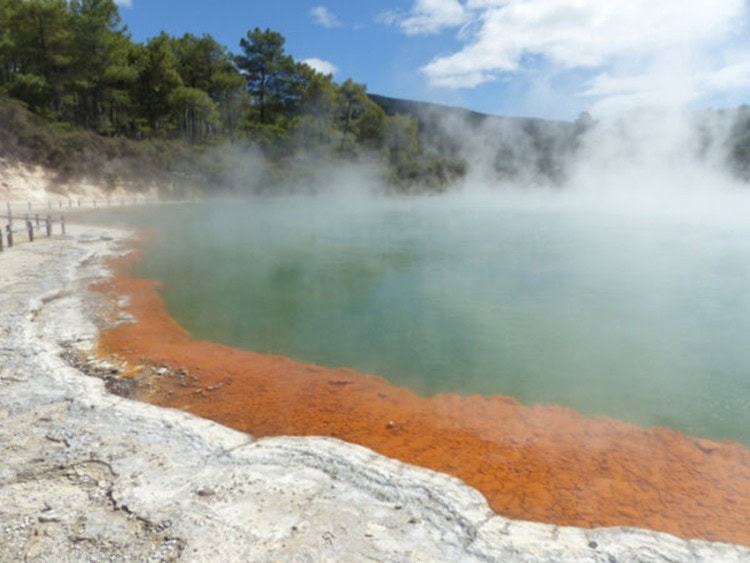
After enjoying the stunningly steamy landscapes at Waiotapu Thermal Wonderland, we drive a few more kilometers to the lovely town of Rotorua (#12).
Staying in Rotorua
I recommend staying in the the charming Millennium Hotel in Rotorua (#13). We’re given a lovely room on the Club floor with access to the swanky Club Lounge where we get free canapes and wine in the evening and breakfast in the morning.
Here’s a map showing some other options:
After getting settled at the hotel and enjoying some free canapes and champagne, we get ready to go do our first of two Māori experiences that we’ve booked in Rotorua.
Māori Experience #1: Te Pau Tu – The Gathering Place
Our first experience is at Te Pau Tu – The Gathering Place (#14). Our ticket includes a pick-up from our hotel.
During the fifteen-minute drive to Te Pau Tu, the voluble Māori guide entertains us with a commentary about the village and what we are about to experience.
One of the men from the tour group is appointed our Chief. The driver explains that when we arrive at Te Pau Tu, we will experience the traditional Māori welcome challenge. Warriors will come out of the village and challenge the visitors.
We are cautioned to not, on any account, laugh or even smile at the actions of the warriors. We are, however, allowed to take pictures.
Arrival at Te Pau Tu
We arrive at the village and join another four tour groups, each with its own chief (all men). The five chiefs are lined up in front of the 150 visitors (or thereabouts) and await the arrival of the warriors and the commencement of the welcome ceremony.
Everyone takes the request to keep a straight face very seriously. No one dares even crack a smile.
Three women appear above the entranceway and blow conch shells to announce the arrival of a canoe paddled by five warriors. They stamp and roll their eyes and stick out their tongues as we all watch with sober concentration.
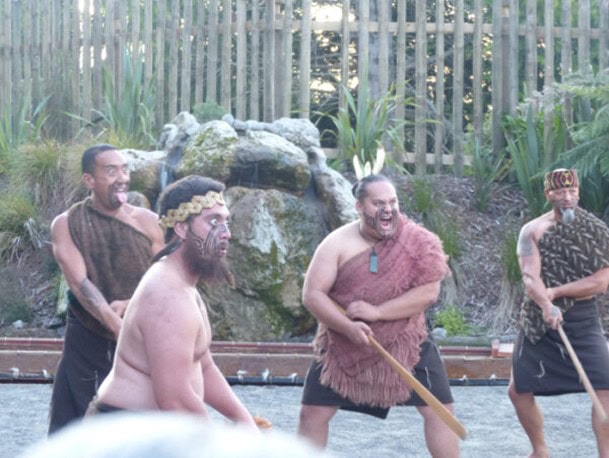
Finally, a branch is laid at the feet of each chief and noses pressed twice, called the hongi. That is the signal that the welcoming ceremony is complete and the visitors mau enter the village.
We are also allowed to talk and smile again.
Craft Demonstrations
As darkness falls, we file into a recreation of a Māori village and are separated into five groups. Each group is taken around to five different learning huts where we are given demonstrations of various Māori crafts and practices.
We learn how the Haka is performed, watch a demonstration of games played back in the day to train warriors, learn that the word “tattoo” is a Māori word, see a demonstration of the poi balls used by the women in dances, and learn about Māori weaving.

The demonstrations are very well done by the men and women who participated in the welcome ceremony. The atmosphere is relaxed and cheerful. It feels like a family business that is really making a solid go of it.
Performance and Dinner
After the demonstrations, we watch the food that will be served for dinner being lifted from the ground. The cooking process on hot rocks under the earth is called Hangi.
We then enjoy a performance of songs and dances before being directed into the dining hall to enjoy a buffet dinner of chicken, lamb, and vegetables cooked in the ground and several good desserts (not cooked in the ground).
On the way back to the hotel on the bus, our entertaining driver sings songs—some solo and some participatory.
Get your tickets well in advance for the Te Pa Tu Māori Cultural Experience with Dinner:
A Day in Rotorua
After a lovely breakfast in the exclusive Club Lounge at the Millenium, which we have virtually ourselves, we set off to tour the Rotorua Museum (#15). On the way, we stop to admire a fantastic yarn-bombed tree outside the Rotorua Arts Centre.

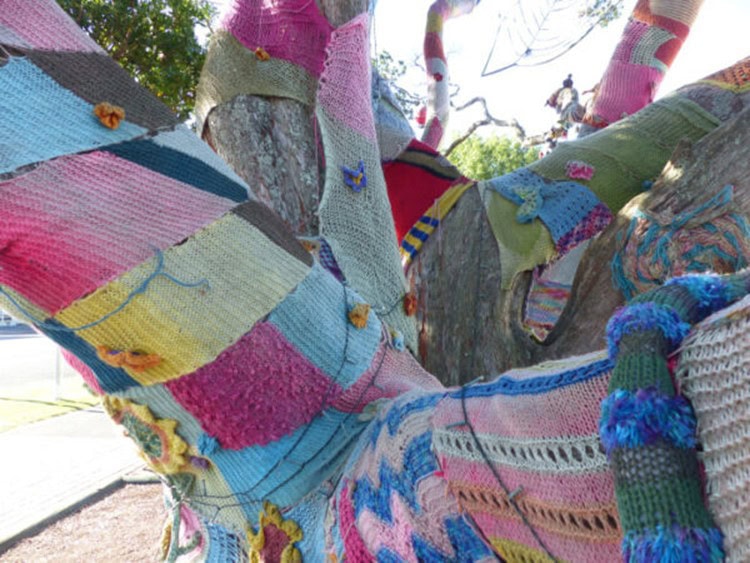
It’s Sunday morning and a small craft market is set up on the grounds of the arts centre. Julia stops to buy some crocheted measuring tapes and chat with the lady about crochet.
We start by touring the grounds of the Rotorua Museum—a fabulous, Tudor-style concoction that once housed the hot spring baths that attracted visitors from all over the world. The grounds also include a rose garden.
Laughing Pool
I take pictures while Julia amuses herself by throwing her shadow over the roses just as I snap them. She can’t stop laughing.
Minutes later we walk to the lake edge—a steaming expanse of geothermal activity dotted with signs warning against leaving the track. One of the many interpretative plaques tells us that a small natural pool just off the track is called the Laughing Pool.
Apparently, the gasses emitted make everyone who takes a dip in it giddy with laughter. Hmm. That might explain our strange outbursts of hilarity.
Rotorua Museum
The Rotorua Museum has an excellent display about the Māori people from the time they arrived in New Zealand about 1,000 years ago to today. We have a hard time tearing ourselves away.
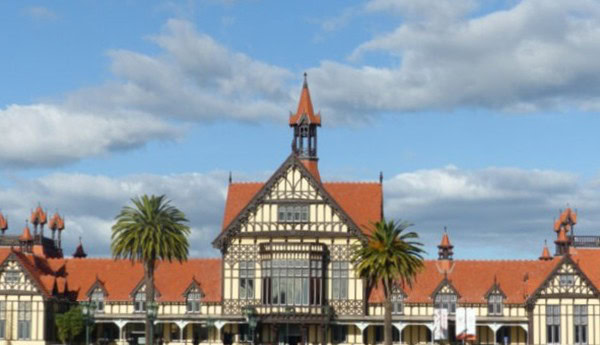
Hell’s Gate Geothermal Reserve and Mud Baths
Hell’s Gate (#16) is a geothermal area of steaming, bubbling gray pools that also includes mud and sulfur baths open to the public.
I’ve always wanted to roll around in a mud bath. Don’t ask me why. Maybe I was a hippopotamus in a former life.
We arrive at Hell’s Gate in the early afternoon and pay the admittedly steep admission fee. If you don’t have your own wheels, you can take a half-day tour from Rotorua to Hell’s Gate with GetYourGuide:
After arriving, we stroll around the geothermal areas in search of an area to enjoy our picnic lunch before plunging into the mud and sulfur pools.
We find a picnic table up in the trees, a little bit away from the pungent sulfur smells gushing out of the hissing steam holes and mud pots. Two large tour groups from a cruise ship stampede past.
Instead of following them to see what else the area has to offer (a hot water waterfall and geyser well worth seeing), we slip around them to start our mud/sulfur bath experience, secure in the knowledge that the bathing area is too small to accommodate the tour groups.
Experiencing the Mud and Sulfur Pools
We strip to our bathing suits and are directed to one of three gray pools. Ours is quite large and unoccupied.
I had envisioned a kind of mud pile that I roll around in, but the reality is a warm pool of gray water that a lot of other people have sat in. We inch in, feeling globs of mud under our feet.
We soon realize that the drill is to scoop up handfuls of mud and smear them all over our arms, necks, and faces. Of course every time I dip my arm into the muddy water (it’s about two feet deep), I wash off the mud I’d just slathered on.

Some skill and foresight is required to achieve, and more importantly sustain, sufficient coverage. We are allowed to spend up to twenty minutes in the mud pool which turns out is more than enough.
After clambering out, we take a good long shower and then inch into the hot sulfur pool which is really just a big hot pool. The sulfur pool is quite a bit hotter than the mud pool so we last about ten minutes before deciding to call it a day.
We shower and get dressed, stop into the gift shop, have a quick ice cream cone, and return to the parking lot.
Should you go? It’s expensive; I’ve not going to lie. But then again, when do you ever get to roll around in mud? I’m glad I went, although the sulfur smell impregnates my bathing suit with such ferocity that several washings, along with dips in pools and the ocean was not sufficient to remove the smell.
If you go, consider wearing an old bathing suit that you’ll not mind tossing after the experience.
Te Puia Māori Experience
In the late afternoon, we set off for our second Māori, this one at Te Puia (#17), one of Rotorua’s major geothermal attractions that includes a kiwi habitat; a school for Māori carving, weaving, and stonework; and Rotorua’s biggest geyser.
The bus picks us up first and then trundles all over Rotorua picking up more people until finally we arrive at Te Puia and get a sticker designating us as Combo Visitors.
We get the guided tour of the grounds followed by a Māori welcome, a song and dance performance, and the feast. The experience lasts about five hours.
Here’s some tour options with GetYourGuide:
Guided Tour
A Māori guide takes us around the grounds with a group of about forty people. We are lucky to arrive at the main geyser just as it blows its top—an impressive site indeed.
The craft areas are pretty much deserted since it’s a Sunday and few students are working. No problem—we get extra time in the fine gift store.
Māori Welcome
We are assembled in front of the Marae—the meeting house—at around six pm to witness the traditional Māori welcome.
The ceremony is the same as the night before, although this time only one man is designated chief. We are again requested not to smile or laugh during the ceremony. Several warriors emerge from the Marae and challenge the group with gestures and stylized movements.
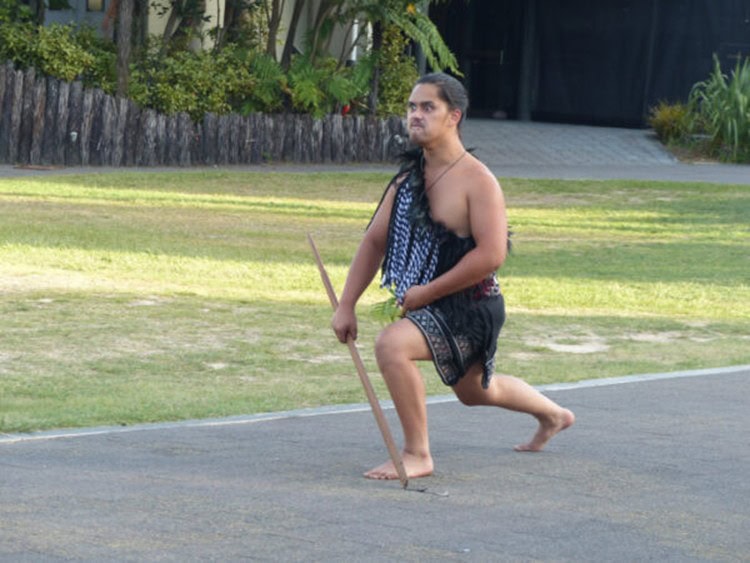
When finally the branch is laid in front of the chief and accepted, we are welcomed into the Marae for the performance. The dancers are as energetic as the ones the night before.
Buffet Dinner
The buffet dinner of the hangi and other food served after the performance is a bit posher than the dinner we had the night before. There is a greater variety of food and the dining area is a bit more upscale.
Geyser Gazing
The Te Puia experience also includes a last look at the geyser in the moonlight. We board a jitney that takes us out to the geothermal area where our host talks about Māori legends and traditions while we wait for the geyser to blow.
It usually performs hourly, but of course the exact timing cannot be predicted. We are very fortunate when just ten minutes before we are due to return to the front entrance, the geyser decides to put on a spectacular show. Plumes thirty meters high shoot straight up into the star-spattered sky, the heat steaming glasses and cameras.
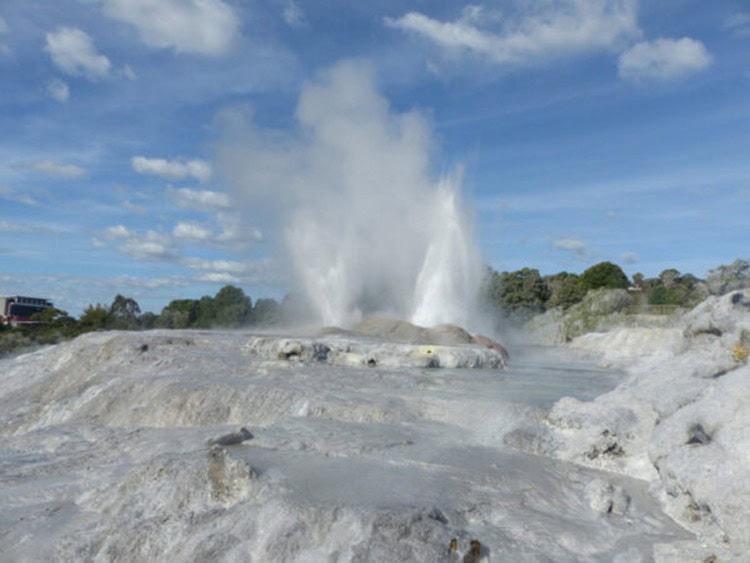
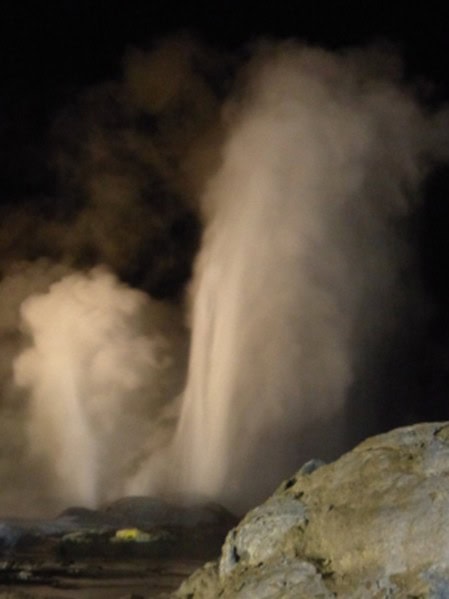
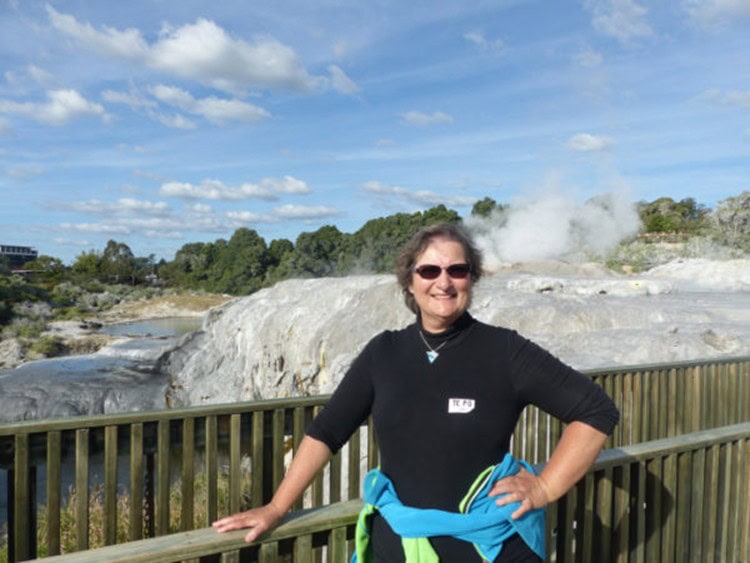
It’s a magical end to the evening.
Which Māori Experience?
So which Maori experience do I recommend? I honestly can’t decide because both are awesome. I think my recommendation would be to go see the geysers and geothermal activity at Te Puia (and they really do have a great gift store) and then do the dinner evening at Te Pau Tu – The Gathering Place
The Te Pau Tu experience is less posh than Te Puia, but a bit more authentic-feeling. The performers talk with small groups of people while they demonstrate the various crafts. Both experiences feel like family affairs (which I believe they are).
The main point is that a visitor to Rotorua should experience at least one Māori evening that includes, at a minimum, the welcome ceremony, the hangi, and a performance.
Although both evenings cater to tourists (well, who else?), the cheerfulness and enthusiasm of the guides and performers feels genuine.T
Conclusion: Steam and Story
From the icy volcanic peaks of Tongariro to the bubbling mud of Rotorua, this steamy center of New Zealand’s North Island feels alive in a way few places do.
The ground moves, the air steams, the legends breathe. You can hike across a mountain born of fire in the morning and soak in a hot spring by night. It’s elemental, theatrical, and utterly unforgettable — a reminder that in New Zealand, the earth doesn’t just sit quietly beneath your feet. It performs.
